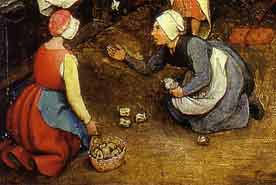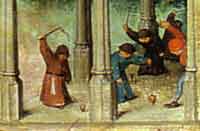| Archery |
| Brewing |
| Calligraphy & writing |
| Combat |
| Cooking |
| Dance |
| Etiquette |
| Household life |
| Medicine |
| Music |
| Needlework |
| Playacting |
| Religion |
| Storytelling |
Childhood is a relatively modern concept: until quite recently, children were expected to undertake responsible tasks within the limit of their abilities; the games and playthings now seen as belonging to the domain of youth, were enjoyed by people of all ages within the limit of their physical capabilities. Society was not stratified by age groups: older people were likely to be involved both in play and supervising the young. We recommend that by adopting this same pattern, children will play safely and adults have fun, too! Please note that the manufactured wooden toys bear the CE label. They
have been sanded and oiled. The knucklebones are extracted from cooked
pig’s feet which have been cleaned, reboiled and oven-dried for
hyqiene. They have been used as toys for many centuries. To re-sterilise
place in a warm oven for ten minutes. Traditional toys need skill: they were devised before instant entertainment was available. Be patient and be prepared to spend time learning how to use them - you’ll be surprised how quickly your coordination and dexterity improves! When nearly everything was done by hand, such play was a useful training. |

Knucklebones Two basic ideas are used: To start a turn, the player throws the five knucklebones
into the air with one hand and tries to catch as many as possible on the
back of the same hand. The bones that were caught are then thrown
up again from the back of the hand where they came to rest and as many
as possible are caught in the palm of the same hand. If no bones
are caught, the player's turn is over. |
Medieval Games for Three Dice Hazard (for two players) Half Hazard (for two players) Pair and Ace As Many on One as on Two Triga |

Whipping Top Use the whipping top in as spacious an area as possible.
You need a smooth, hard surface. If you are right handed, wrap the whip
clockwise around the top. Place it upright on the ground and steady it
by placing a finger of the left hand in the centre of the flat surface.
Now pull the whip away sharply to start the top spinning. |